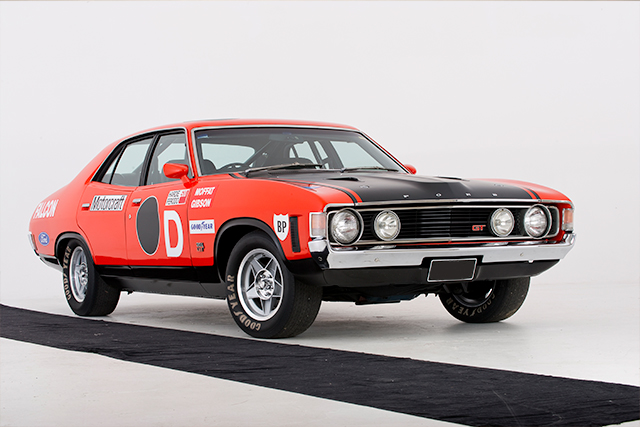“Everyone’s a winner, baby” goes the refrain in that song from Hot Chocolate, and there were two winners at a recent Lloyd’s classic car auction. Showing that taste and money can combine well, two absolute Australian classic car rarities were sold for two million dollars or more. One of these is possibly amongst the rarest cars the planet has seen, the other a car attached to a name that is synonymous with Australian motorsport.
In the early 1970s Ford Australia had produced the world’s fastest four door sedan. The Ford Falcon XY GT-HO Phase III was powered by a 5.8L, 351 cubic inch pushrod V8.Top speed just shy of 230 kph and would see the Phase III reach one hundred kilometers per hour in a then astonishing six and a half seconds.
Development was underway on its replacement. Based on the slimmer, sleeker, less angular, XA Falcon, the Phase IV would have been the next chapter in Ford’s already illustrious muscle car history. Prototype cars had been engineered and built, however a media frenzy erupted.
In 1972 two journalists had discussed the planned release of the XA Phase IV. A story was printed and this quickly attracted the ire of politicians around the country. Just as quickly as the fire erupted, the program from Ford, with Holden and Chrysler also in similar development situations, was cancelled.
Journalist Harvey Grennan, the man said to be the catalyst for the cancellation, says there were four cars built, of which three were Brambles Red in colour were destined for the race track. The other was a production built Calypso Green and the only Phase IV to be fitted with a compliance plate.
Extra work was performed on the cars, such as changing the seat material to cloth instead of vinyl, and removing the radios. When the balloon went up, the cars were, as Grennan put it, “…quietly sold out the back door for as little as $3500…”.
Two of the red cars were destined for Fred Gibson and Allan Moffat, with the third being a spare. Moffat’s machine was sold to a rally driver and from there to the Bowden family collection. Another was sold to a rally driver, who on-sold it, with that car destroyed in a crash, said Grennan. The third car, and the one sold at Lloyd’s, was bought by collector Paul Carthew in 2000. The Calypso Green road car was sold via Jack Brabham Ford in Sydney, and after a handful of owners has enjoyed a mostly pampered life since the mid 1980s
Moffat was in attendance at the auction and was the person that “dropped the hammer” to conclude the bidding, with the Phase IV going for two million dollars. Chief Marketing Officer for Lloyd’s, Brett Mudie, said: “It didn’t surprise me that the car sold for this amount. We were expecting it to smash the last record quite easily, with bidding already at $1.5 million 3 days before the auction. The Phase IV’s limited number, immaculate condition, celebrity affiliation (with links to Fred Gibson and Allan Moffat) along with its chrome bumper all contributed to the car selling at this price and will underpin its value into the future.”
The other vehicle sold was born of the factory that was Ford’s biggest rival, and developed by Moffat’s friend and racing sparring partner, Peter Brock. The 1982 HDT VH Commodore was sold for $2.1 million, with its own piece of history being the first car to win the Bathurst 1000 twice in a row. In this car, “Peter Perfect” was King of the Mountain in 1982 and 1983.
HDT itself goes back to the 1960s and was a racing arm of Holden put together by Harry Firth. Drivers included Brock, and Colin Bond, with Firth seeing Brock’s potential as a race driver then. In 1979 Brock bought the HDT name and commenced an aftermarket company in 1980 called HDT-SV. Their first road car was based on the VC Commodore, the second model in the relatively new to market Commodore range.
One of Brock’s best mates, another Peter and with a surname related to motorsport, Peter Champion, took over the company after Brock’s tragic death in 2006. A wealthy business man in his own right, Champion had put together Australia’s largest collection of Brock cars, including the VH up for auction. Of the car and Brock himself, Champion says: “This result shows that Peter’s legacy lives on, and that people valued him not only as one of the best drivers in motorsport, but as a person.”
Champion had put most of the collection up for sale in 2013, with the proviso the cars remain together. The “Champion’s Brock Experience” was relocated to the DreamWorld theme park in Queensland from Champion’s Yeppoon base in 2015, where an anonymous collector bought the cars
The queues of people at motorsport events before Brock’s passing are testament to that, as are the immense amount of items signed by the legendary driver.
